
Strontianite (SrCO3) is an important raw material for the extraction of strontium. It is a rare carbonate mineral and one of only a few strontium minerals. It is a member of the aragonite group.

Bytownite is a calcium rich member of the plagioclase solid solution series of feldspar minerals with composition between anorthite and labradorite. It is usually defined as having between 70 and 90%An. Like others of the series, bytownite forms grey to white triclinic crystals commonly exhibiting the typical plagioclase twinning and associated fine striations.

Vivianite (Fe(II)
3(PO
4)
2·8H
2O) is a hydrated iron(II) phosphate mineral found in a number of geological environments. Small amounts of manganese Mn2+, magnesium Mg2+, and calcium Ca2+ may substitute for iron Fe2+ in its structure. Pure vivianite is colorless, but the mineral oxidizes very easily, changing the color, and it is usually found as deep blue to deep bluish green prismatic to flattened crystals. Vivianite crystals are often found inside fossil shells, such as those of bivalves and gastropods, or attached to fossil bone. Vivianite can also appear on the iron coffins or on the corpses of humans as a result of a chemical reaction of the decomposing body with the iron enclosure.
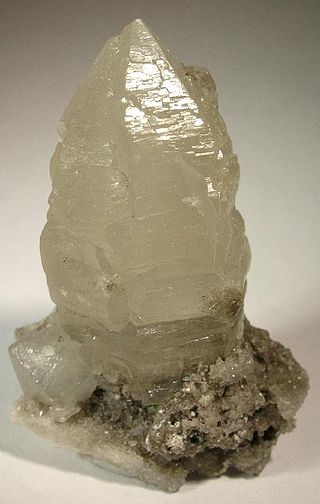
Witherite is a barium carbonate mineral, BaCO3, in the aragonite group. Witherite crystallizes in the orthorhombic system and virtually always is twinned. The mineral is colorless, milky-white, grey, pale-yellow, green, to pale-brown. The specific gravity is 4.3, which is high for a translucent mineral. It fluoresces light blue under both long- and short-wave UV light, and is phosphorescent under short-wave UV light.

Barytocalcite is an anhydrous barium calcium carbonate mineral with the chemical formula BaCa(CO3)2. It is trimorphous with alstonite and paralstonite, that is to say the three minerals have the same formula but different structures. Baryte and quartz pseudomorphs after barytocalcite have been observed.

Leadhillite is a lead sulfate carbonate hydroxide mineral, often associated with anglesite. It has the formula Pb4SO4(CO3)2(OH)2. Leadhillite crystallises in the monoclinic system, but develops pseudo-hexagonal forms due to crystal twinning. It forms transparent to translucent variably coloured crystals with an adamantine lustre. It is quite soft with a Mohs hardness of 2.5 and a relatively high specific gravity of 6.26 to 6.55.
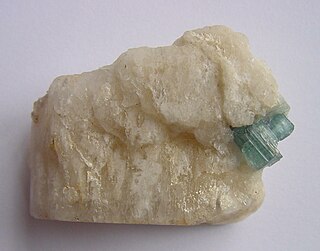
Beryllonite is a rare phosphate mineral with formula NaBePO4. The tabular to prismatic monoclinic crystals vary from colorless to white or pale yellowish, and are transparent with a vitreous luster. Twinning is common and occurs in several forms. It exhibits perfect cleavage in one direction. The hardness is 5.5 to 6 and the specific gravity is 2.8. Refractive indices are nα = 1.552, nβ = 1.558 and nγ = 1.561. A few crystals have been cut and faceted, but, as the refractive index is no higher than that of quartz, they do not make very brilliant gemstones.

Vauxite is a phosphate mineral with the chemical formula Fe2+Al2(PO4)2(OH)2·6(H2O). It belongs to the laueite – paravauxite group, paravauxite subgroup, although Mindat puts it as a member of the vantasselite Al4(PO4)3(OH)3·9H2O group. There is no similarity in structure between vauxite and paravauxite Fe2+Al2(PO4)2(OH)2·8H2O or metavauxite Fe3+Al2(PO4)2(OH)2·8H2O, even though they are closely similar chemically and all minerals occur together as secondary minerals. Vauxite was named in 1922 for George Vaux Junior (1863–1927), an American attorney and mineral collector.
Zircophyllite is a complex mineral, formula (K,Na)3(Mn,Fe)2+7(Zr,Ti,Nb)2Si8O24(OH,F)7. It crystallizes in the triclinic – pinacoidal crystal class as dark brown to black micaceous plates. It has perfect 001 cleavage, a Mohs hardness of 4 to 4.5 and a specific gravity of 3.34. Its indices of refraction are nα=1.708 nβ=1.738 nγ=1.747 and it has a 2V optical angle of 62°.

Nyerereite is a very rare sodium calcium carbonate mineral with formula Na2Ca(CO3)2. It forms colorless, platey pseudohexagonal orthorhombic crystals that are typically twinned. It has a specific gravity of 2.54 and indices of refraction of nα=1.511, nβ=1.533 and nγ=1.535. Nyerereite is not stable in contact with the atmosphere and rapidly breaks down. Collection specimens must be kept in a sealed argon environment.

Sarabauite (sar-a-bau'-ite) is a red monoclinic sulfide mineral with the chemical formula: CaSb10O10S6.

Studenitsite is a rare borate mineral with chemical formula of NaCa2[B9O14(OH)4]·2H2O.
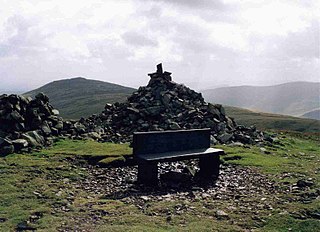
Ianbruceite is a rare hydrated zinc arsenate with the formula [Zn2(OH)(H2O)(AsO4)](H2O)2; material from the Driggith mine has traces of cobalt. It was first discovered at Tsumeb, approved by the International Mineralogical Association as a new mineral species in 2011, reference IMA2011-49, and named for Ian Bruce, who founded "Crystal Classics" in the early 1990s, and was heavily involved in attempts to reopen the famous Tsumeb mine for specimen mining.
In 2013 new occurrences of ianbruceite were reported from the neighbouring Driggith and Potts Gill mines on High Pike in the Caldbeck Fells, Cumbria, England. Here the mineral is probably a post-mining product. Caldbeck Fells and Tsumeb are the only reported localities for ianbruceite to date (May 2013).

Köttigite is a rare hydrated zinc arsenate which was discovered in 1849 and named by James Dwight Dana in 1850 in honour of Otto Friedrich Köttig (1824–1892), a German chemist from Schneeberg, Saxony, who made the first chemical analysis of the mineral. It has the formula Zn3(AsO4)2·8H2O and it is a dimorph of metaköttigite, which means that the two minerals have the same formula, but a different structure: köttigite is monoclinic and metaköttigite is triclinic. There are several minerals with similar formulae but with other cations in place of the zinc. Iron forms parasymplesite Fe2+3(AsO4)2·8H2O; cobalt forms the distinctively coloured pinkish purple mineral erythrite Co3(AsO4)2·8H2O and nickel forms annabergite Ni3(AsO4)2·8H2O. Köttigite forms series with all three of these minerals and they are all members of the vivianite group.

Rampgill mine is a disused lead mine at Nenthead, Alston Moor, Cumbria, England UK Grid Reference: NY78184351

Carminite (PbFe3+2(AsO4)2(OH)2) is an anhydrous arsenate mineral containing hydroxyl. It is a rare secondary mineral that is structurally related to palermoite (Li2SrAl4(PO4)4(OH)4). Sewardite (CaFe3+2(AsO4)2(OH)2) is an analogue of carminite, with calcium in sewardite in place of the lead in carminite. Mawbyite is a dimorph (same formula, different structure) of carminite; mawbyite is monoclinic and carminite is orthorhombic. It has a molar mass of 639.87 g. It was discovered in 1850 and named for the characteristic carmine colour.

Serpierite (Ca(Cu,Zn)4(SO4)2(OH)6·3H2O) is a rare, sky-blue coloured hydrated sulfate mineral, often found as a post-mining product. It is a member of the devilline group, which has members aldridgeite (Cd,Ca)(Cu,Zn)4(SO4)2(OH)6·3H2O, campigliaite Cu4Mn2+(SO4)2(OH)6·4H2O, devilline CaCu4(SO4)2(OH)6·3H2O, kobyashevite Cu5(SO4)2(OH)6·4H2O, lautenthalite PbCu4(SO4)2(OH)6·3H2O and an unnamed dimorph of devilline. It is the calcium analogue of aldridgeite and it is dimorphous with orthoserpierite CaCu4(SO4)2(OH)6·3H2O.
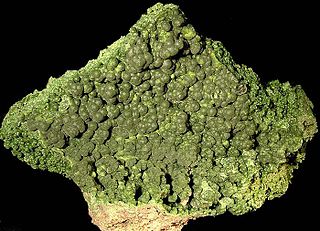
Mottramite is an orthorhombic anhydrous vanadate hydroxide mineral, PbCu(VO4)(OH), at the copper end of the descloizite subgroup. It was formerly called cuprodescloizite or psittacinite (this mineral characterized in 1868 by Frederick Augustus Genth). Duhamelite is a calcium- and bismuth-bearing variety of mottramite, typically with acicular habit.
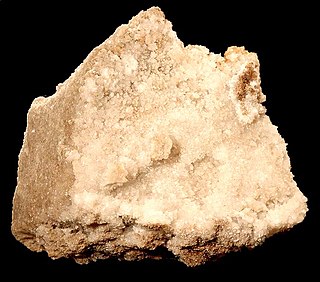
Talmessite is a hydrated calcium magnesium arsenate, often with significant amounts of cobalt or nickel. It was named in 1960 for the type locality, the Talmessi mine, Anarak district, Iran. It forms a series with β-Roselite, where cobalt replaces some of the magnesium, and with gaitite, where zinc replaces the magnesium. All these minerals are members of the fairfieldite group. Talmessite is dimorphic with wendwilsonite.
Raygrantite is a mineral first discovered in Big Horn Mountains, Maricopa County, Arizona, US. More specifically, it is located in the evening star mine, which is a Cu, V, Pb, Ag, Au, and W mine. Raygrantite is a member of the iranite mineral group, which consists of hemihedrite, iranite, and raygrantite. This mineral received its name in honor of Raymond W. Grant, a retired professor who primarily focused on the minerals of Arizona. The typical crystal structure of raygrantite is bladed with parallel striations to the C axis. Its ideal chemical formula is Pb10Zn(SO4)6(SiO4)2(OH)2. The IMA (International Mineralogical Association) approved raygrantite in 2013, and the first publication regarding this mineral was put forth in 2017.



















